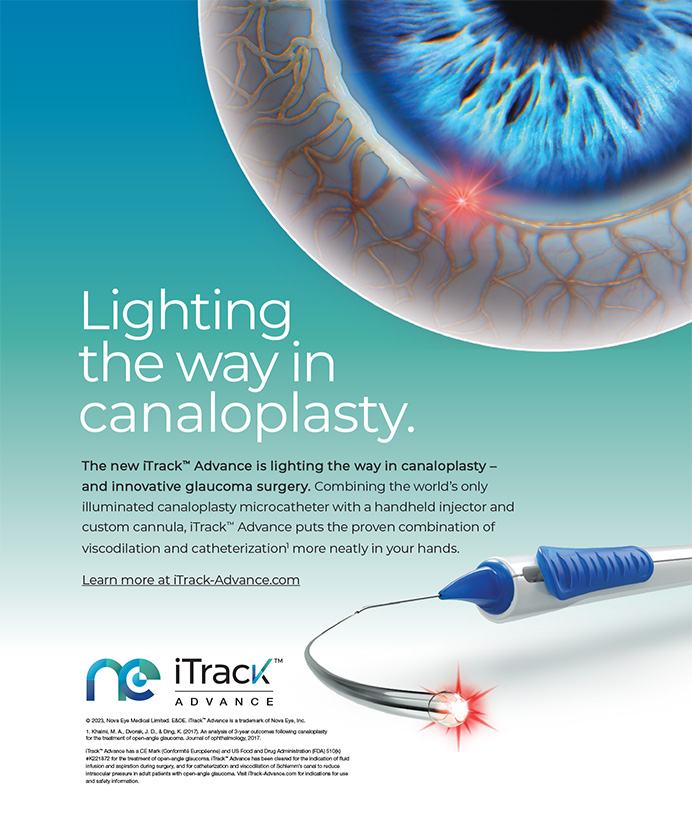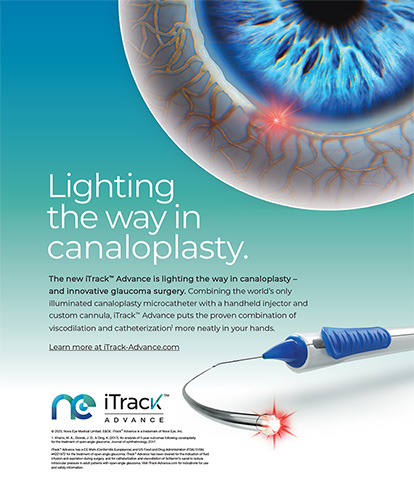Daniel H. Chang, MD
Once I determine the need for an IOL exchange, I operate as soon as possible to minimize the time for capsular fibrosis to develop. I reopen the paracentesis and operative wound with a blunt dissection to prevent crosscuts and multiplanar incisions. As I inject a cohesive viscoelastic, I direct the cannula under the anterior capsular leaflet where it overlaps the IOL's optic. If needed, I use a blunt instrument or possibly a needle to initiate a separation of the capsule from the IOL but take care not to tear the anterior capsule. Next, I reopen the capsular bag as fully as possible with viscoelastic and gentle dissection, while paying particular attention to the haptics. I then rotate the IOL clockwise to free the haptics, but I am careful to minimize stress on the zonules. Next, I place viscoelastic between the optic and the posterior capsule.
I bisect three-piece IOLs with a long Vannas scissors prior to the lenses' removal, but I prefer to remove single-piece IOLs without cutting or folding. Using a trapezoidal configuration with a larger internal wound, I enlarge the wound to approximately 3 mm. I then grasp the IOL at the haptic-optic junction with a 0.12-mm forceps and pull slowly. The IOL will fold automatically as it slides out of the eye. I prefer this method to cutting or folding the IOL with an instrument, because it minimizes the need for specialized equipment. Additionally, I do not need to perform complex bimanual intraocular maneuvers, and I will not inadvertently create sharp edges on the IOL while it is in the eye. I have had no cases of corneal edema and have achieved excellent visual outcomes with this technique.
Bonnie An Henderson, MD
The method used for removing an IOL depends on the material and model of the IOL. For silicone IOLs, I cut the optic in half and remove the lens through a 3- to 3.2-mm incision. For some acrylic IOLs such as the Tecnis or Sensar (both from Abbott Medical Optics Inc.), I refold the IOL and remove it through a 3- to 3.2-mm incision. Other acrylic IOLs such as the AcrySof (Alcon Laboratories, Inc.) can be removed through an incision of 2.8 mm or larger without requiring cutting or folding. After prolapsing the IOL into the anterior chamber, I bring one haptic out of the incision. Using a toothed forceps, I grasp the optic with my dominant hand, and with my nondominant hand, I simultaneously use a lens manipulator (such as a Kuglen, Sinskey, or Osher Y hook) placed 180º away from the incision to push the optic toward the incision.1
For all of these methods, it is important to use abundant viscoelastic to fully dissect the IOL from the capsular bag. If the opening of the anterior capsulorhexis overlies the optic, then it is easy to lift the edge of the capsule off the optic with a 30-gauge needle attached to the viscoelastic syringe. Once the optic is dissected, both haptics should also be freed of any adhesions. Injecting viscoelastic along the length of the haptic will facilitate dissection. If the haptics cannot be mobilized, another option is to truncate them at the haptic-optic junction and leave the haptics in place. Another approach is to bisect the IOL in the capsular bag. This can be done after a dispersive viscoelastic has been injected both under and above the IOL to protect the posterior capsule and cornea, respectively, from inadvertent damage. Bisecting the IOL leaves only half of the IOL to manipulate, thereby facilitating its dissection from the capsular bag.
Care should be taken to avoid iatrogenic zonular dialysis during the removal of the optic. Gentle manipulation by rotating the IOL rather than pulling it centrally can decrease the risk of zonulolysis.
Douglas A. Katsev, MD
First, I carefully free the lens from the capsular bag with viscoelastic. I often use a small needle to release an edge of the capsule and thus allow the cannula to fit, and then, I inject the viscoelastic (no need to spare its use in these situations). Careful and slow manipulation can free the lens so that it can be pulled from the capsular bag into the anterior chamber. Sometimes, I use iris hooks to steady an unstable bag in this situation. Once the lens is in the anterior chamber and viscoelastic coats the anterior chamber, I make a 3.5-mm stab incision at the steepest axis. I find that it is usually easy to remove an IOL through this size incision and that it typically folds itself as it leaves the eye.
If the capsular bag is stable, I place the IOL in the capsular bag and close the wound with hydration. If I have any concerns about the stability of the capsular bag, I place a suture. If the capsular bag is not stable, I usually can find stability in the sulcus. I use an IOL with an overall diameter of 13.5 mm and a sulcus-calibrated power (I often use the STAAR AQ 2010V [STAAR Surgical Company]). I am not afraid to place an ACIOL if the bag may be compromised and the patient does not have a history of glaucoma. In cases with an unstable capsular bag and glaucoma, I would not hesitate to suture in a PCIOL such as Alcon's CZ70BD IOL, which has eyelets on the haptics.
Lindsay Ong-Tone, FRCSC
To remove a foldable IOL from the posterior segment, I make a regular phaco incision. If the lens is in the capsular bag and the anterior capsulorhexis covers the lens' optic, I attempt to lift the anterior capsule from the optic with the tip of a 27-gauge cannula attached to a viscoelastic syringe. I then inject the viscoelastic under the anterior capsule to lift it from the optic's surface. This maneuver can be quite challenging at times. If I am unable to lift the anterior capsule with a cannula, I use a bent 25-gauge needle. The needle is bent toward the bevel, and I use the smooth side to lift up the capsulorhexis (Mike Snyder, MD, personal communication, June 2010). Once the bag has been opened, I dial the IOL out of the bag. I pull one lens haptic out of the wound to stabilize the lens, and I use a pair of lens cutting scissors (Packer/Chang IOL Cutters; Microsurgical Technology) to cut the lens in the middle to about three-quarters of the way down. The whole lens can then be pulled out through the wound.
If the anterior capsulorhexis is larger than the optic, and the anterior capsule firmly adheres to the posterior capsule, it is usually difficult to separate them without damaging the posterior capsule. When dealing with a three-piece IOL, the surgeon can attempt to dial the haptic out of the bag. In the case of a single-piece IOL, an attempt can be made to lift the anterior capsule from the haptic. If that is not possible, the haptic can be cut off and left behind, and then, the optic can be cut and removed as previously described.
Section Editor Alan N. Carlson, MD, is a professor of ophthalmology and chief, corneal and refractive surgery, at Duke Eye Center in Durham, North Carolina. Section Editor Steven Dewey, MD, is in private practice with Colorado Springs Health Partners in Colorado Springs, Colorado. Dr. Dewey may be reached at (719) 475-7700; sdewey@cshp.net.
Section Editor R. Bruce Wallace III, MD, is the medical director of Wallace Eye Surgery in Alexandria, Louisiana. Dr. Wallace is also a clinical professor of ophthalmology at the Louisiana State University School of Medicine and an assistant clinical professor of ophthalmology at the Tulane School of Medicine, both located in New Orleans.
Daniel H. Chang, MD, is a partner at Empire Eye and Laser Center in Bakersfield, California. Dr. Chang may be reached at (661) 325- 3937; dchang@empireeyeandlaser.com.
Bonnie An Henderson, MD, is a partner in Ophthalmic Consultants of Boston and an assistant clinical professor at Harvard Medical School in Boston. She is a consultant to Alcon Laboratories, Inc., and Ista Pharmaceuticals, Inc. Dr. Henderson may be reached at (781) 487- 2200, ext. 3321; bahenderson@eyeboston.com.
Douglas A. Katsev, MD, is in private practice at the Sansum Santa Barbara Medical Foundation in California. He is a speaker for Alcon Laboratories, Inc. Dr. Katsev may be reached at (805) 681-8950; katsev@aol.com.
Lindsay Ong-Tone, FRCSC, is a clinical assistant professor at the University of Saskatchewan, Saskatoon, Saskatchewan, Canada. He acknowledged no financial interest in the product or company he mentioned. Dr. Ong-Tone may be reached at longtone@myaccess.ca.
- Henderson BA, Yang EB. Intraocular lens explanation technique for one-piece acrylic lenses. J Refract Surg. 2012;8:1-4.


